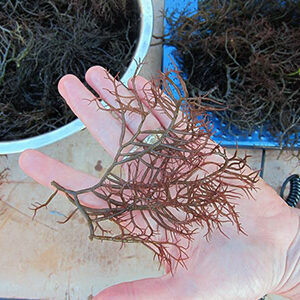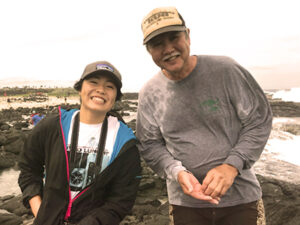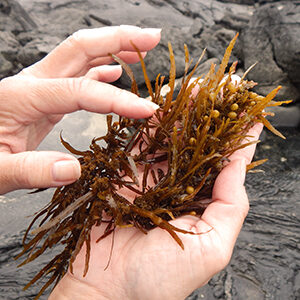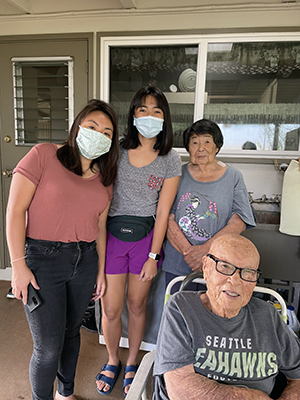Reflections written by Emily Akamine, Student Assistant at Washington Sea Grant for the Indigenous Aquaculture Collaborative. She writes on the importance of seaweed stewardship as cultural resilience in Hawaii.
My grandmother’s stiff hands move swiftly over the branches of Limu Ogo as she cleans each one. I’ve brought her another pound of Ogo from the Limu tanks, which is where I volunteer every Saturday morning. She tells me that you can’t find Ogo like this anymore. My grandfather chimes in at this moment. When he was a young boy growing up on Maui, his family was poor, and his mother could only afford to feed her six children cheap cuts of meat, rice, and Ogo. Back in the day, Limu Ogo was easy to gather. My grandfather would often say, “all you had to do was walk along the beach,” and there would be piles of lumpy Limu covering the white powdery sand. My grandfather would gather Limu with his sisters and bring it home for his mother to pickle with shoyu and vinegar, just like my grandmother was doing now.

Ogo seaweed, source “For the Love of Limu.” Lanai 96763, 11 July 2019.
I help my grandmother pour boiling water over the washed Ogo to blanch it. Next, I add the chopped onions and minced garlic to the soy-vinegar mixture. She tells me what to do, and I inherit her knowledge about Ogo. This transfer of knowledge is important because my grandparents can’t do these things independently anymore. My grandmother’s rheumatoid arthritis prevents her from moving big bags of Ogo, and my grandfather’s back is too weak to help her. So, like many kūpuna (elders), they can no longer do what they know how to do.
I started working with Limu independently through the Ewa Limu Project (ELP) when I was17 as a means to understand a cultural food that was meaningful to my ancestors and give back to the marine environment. The ELP is coordinated by Uncle Wally of Kuaʻāina Ulu ʻAuamo (KUA), who became my mentor for understanding all things Limu. Uncle Wally taught me that Limu is algae that blooms, branches, and flourishes with freshwater. It even encompasses forest lichen, river mosses, fungi, and more. The ELP is interested in Limu in the context of the shoreline because it is the meeting place between the ocean and land; it is the hānau (birthplace for new life). In this coastal meeting place, nitrogen and phosphorus flowing from the land nourishes Limu growth. As Limu flourishes, it provides food, shelter, and a clean environment for marine life. Because of its vital role at the shoreline, the health of Limu is an indicator of health for the environment. For Uncle Wally, Limu’s role at the shoreline is a necessary topic of conversation for Hawaiian communities. It is an essential teaching tool for younger generations as they inherit stewardship responsibilities to the land.

Uncle Wally and Emily
Limu not only gives life to marine animals at the shoreline, but it also holds cultural significance to the people of Hawaiʻi. In popular culture, Limu Ogo is a tasty addition in poké, a Hawaiian dish of raw fish mixed in with savory spices and sauce. It also tastes delicious as a pickled condiment with rice. The intersectionality of local Asians and Native Hawaiians created new cultural traditions and practices around Limu. In the stories that my grandparents tell me, Limu was an important gathering practice for our local Japanese ancestors. For Hawaiians, Limu was also used in ceremonies, religion, and medicine. The many cultural practices around Limu became intertwined and diversified its uses. A great example of a diverse Limu used for healing is Limu Kala. From the shoreline, Limu Kala is an unassuming golden leafy tangle. Limu Kala is used by fishermen as bait to attract Kala (unicornfish) since it is attracted to, and is named after, the food that it loves. Another use for Limu Kala is medicine. If one were to cut themselves on the reef, crushing Kala and placing it over the length of the injury would help heal the lesion. Finally, Limu Kala does not only heal physical injury, but it also carries spiritual healing. In the forgiveness ceremony Ho’o Pono Pono, the two disputing parties each consume a small branch of Limu Kala, internalizing the process of healing. The cultural significance of Limu Kala is immense, as it not only maintains the marine environment but also unifies cultures through their relationship with Limu and its ability to heal the physical and spiritual body.

Limu Kala
Limu will nourish the future of Hawaiʻi just as it has in the past; it’s given me a deeper appreciation for my ancestors who spent time observing and gathering it as they deepened their relationship to place. I continue to practice the values that Limu has taught me, even as I study away from home at the University of Washington. My work as a Student Assistant for the Cross-Pacific Indigenous Aquaculture Collaborative embodies this. The initiatives of this collaborative care for the well-being of coastal peoples by supporting diverse forms of Indigenous aquaculture from Loko I’a (Hawaiian fishponds) to Pacific Northwest clam gardens.

Limu Hui
Amongst Indigenous communities, there is a shared love and respect for the environment, with responsibilities o f stewardship. These shared values, through Indigenous ecological practices, help sustain human health and combat climate change. Warming temperatures, sea level rise, wildfires, drought, and species extinction all threaten the welfare of the world we live in. Indigenous aquaculture practices like Limu stewardship act as tools of resilience in reducing these negative effects of climate change.
Caring for limu teaches us to care for the shoreline, and in this meeting place, we reunite with the history of our ancestors and how their lives depended on giving and receiving from the land. Engaging Limu and its rich cultural history is not an artifact of past times but a tool of resilience for future generations. Limu holds a key to unlocking past sustainable, self-sufficient technologies that nourish both the people and land.

Grandparents
Are you interested in trying your hand at making Ogo? Check out this recipe for My Daddy’s Ogo by Feeding My Ohana.
